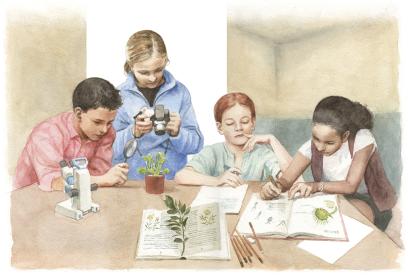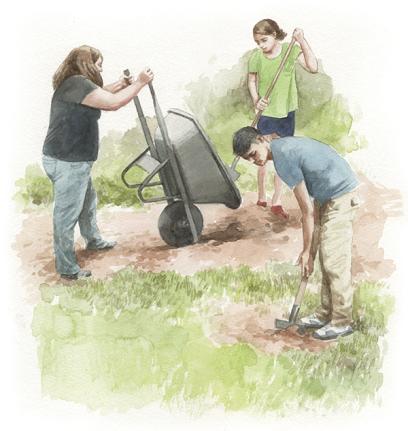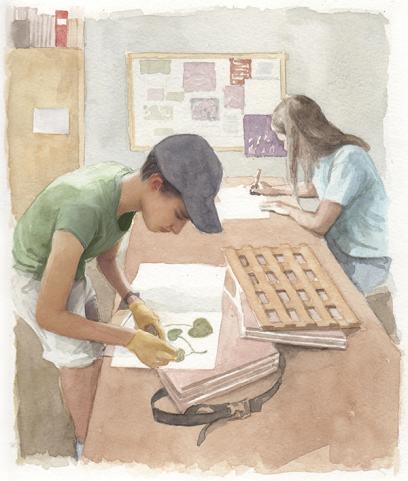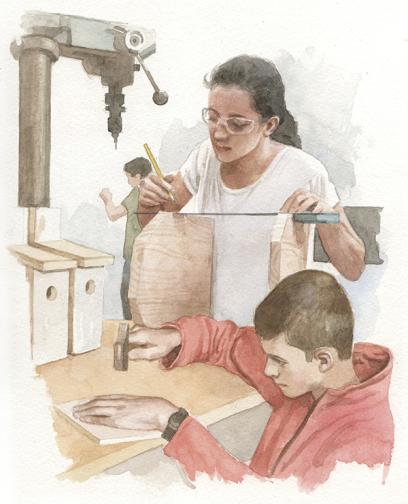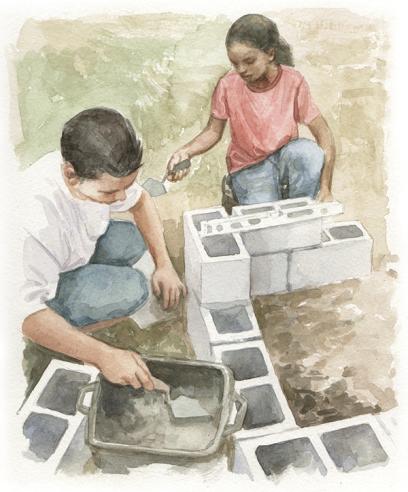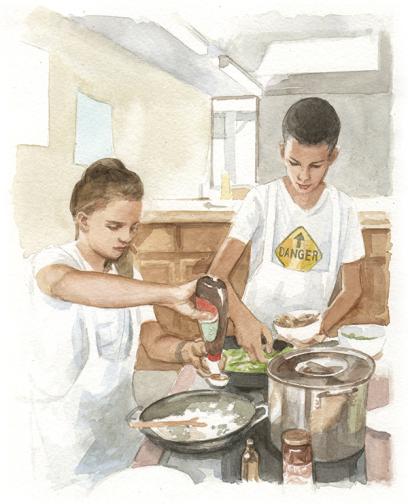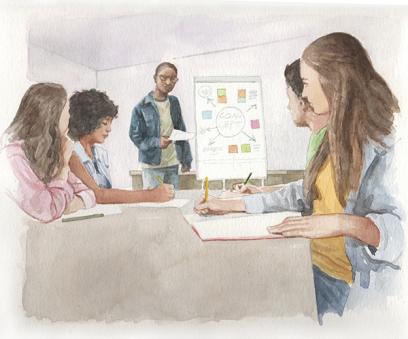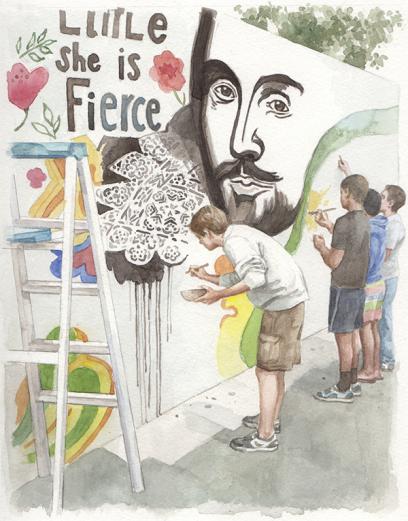New comments have come in on several students’ blog posts. The students look on excitedly as the teacher shows the comments on the Smart Board. Dontae mentions that a neighbor stopped him the other day to talk about the blog. Several students ask the teacher to check on the number of hits the blog has received.
This blog created by third-graders provides information about plants and animals that live around their school. While their blog’s target audience is people who live near the school, they are excited to see comments from people in other parts of the region as well.
Students were inspired to start the blog after learning about Ayana Elizabeth Johnson, who writes a reader-friendly informational blog about marine life, primarily in the Caribbean. The students created their own blog, imitating many of Johnson’s techniques. After learning about how to observe plant and animal life, and then observing the area around their school, each student chose a plant or animal of interest—such as moths, maple trees, snakes, and squirrels, to name a few—and researched it using a variety of informational sources. Like Johnson, the students also interviewed people about their interactions with local plant and animal life. Even in their urban area, they found evidence of a rich array of wildlife.
Over the course of the project, their teacher taught informational reading and writing skills as well as content. For example, the teacher taught students how to organize the information they gathered and plan their writing using a planning map. The teacher knew that this strategy helped address part of a state standard for third-graders to “group related information together” when writing, but the students focused on learning the strategy to help serve the project in which they were so engaged. Indeed, students were engaged throughout the project—even, to the teacher’s delight, during revision and editing. Students’ usual refrains of “I’m done” were replaced with tireless efforts to make their blog posts as informative, clear, and clean as possible before posting them on the Internet for their school neighbors—and all the world—to see.
What I just described is project-based learning.* In this approach, students work over an extended time period for a purpose beyond satisfying a school requirement—to build something, to create something, to respond to a question they have, to solve a real problem, or to address a real need. For example, students might work to plan, plant, and cultivate a garden to help feed the hungry in their community; develop a guidebook for visitors at a nature preserve; study the problem of wasting food and then develop a plan to reduce waste in the school cafeteria; or research and write a history of their local community. Along the way, teachers build knowledge and teach skills, but in students’ minds, the knowledge and skills serve to meet the project’s goal (while in the teacher’s mind, they may also address specific state standards and meet district curriculum requirements).
Understanding Project-Based Learning
In part because it often addresses real-world opportunities and problems, project-based learning is typically interdisciplinary. For example, developing a guidebook for visitors at a nature preserve may involve work commonly associated with social studies, such as surveying visitors about their interests and researching the history of the preserve, as well as work commonly associated with science, such as observing and describing plant and animal life in the preserve.
Projects often involve a great deal of reading and writing, as in the guidebook project, for instance, which could entail writing surveys; reading, analyzing, and writing up the survey results; reading and synthesizing historical documents about the preserve; recording observations; and writing the guidebook itself. Students usually must communicate, both orally and in writing, with people outside of the classroom, such as the ranger of the preserve. Within the classroom, considerable speaking and listening are typically required as students work together to achieve project goals. These days, students often also use a wide range of technological tools.
Project-based approaches have been around at least since the beginning of progressive education. In the early 1900s, scholars such as John Dewey and William Heard Kilpatrick argued that learning by doing and making instruction purposeful for children would result in more powerful learning.1
Although such approaches are not new, the time is especially ripe for them. First, the skills entailed in project-based learning are consistent with the so-called “21st-century skills”—creativity, critical thinking, and collaboration, among other skills—that are in demand for work and citizenship.
Second, as discussed later in this article, research is increasingly showing that project-based approaches improve students’ knowledge and skills. Some common components of project-based approaches also have support in research. For example, research suggests that reading and writing for specific purposes, beyond just acquiring basic skills and meeting certain school requirements, is associated with stronger reading and writing growth.2 Moreover, project-based approaches often involve writing for specific audiences beyond members of the classroom. Research suggests that students actually write better under such circumstances.3
Third, project-based approaches are more engaging than many traditional kinds of instruction.4 Although motivation and engagement in schooling have always been important, they are more important now than ever. Standards expect much more from students than in the past; for students to engage in the hard, cognitive work necessary to meet these demanding standards, they need to be motivated and engaged in their learning.
Fourth, project-based approaches are particularly well suited to addressing today’s standards. For example, in the Common Core State Standards (CCSS) for English Language Arts and Literacy in History/Social Studies, Science, and Technical Subjects, one of the anchor standards for reading calls for students to “integrate and evaluate content presented in diverse media and formats, including visually and quantitatively, as well as in words,” as students are likely to do in projects. Likewise, an anchor standard for speaking and listening calls for students to “present information, findings, and supporting evidence such that listeners can follow the line of reasoning and the organization, development, and style are appropriate to task, purpose, and audience.” And an anchor standard for writing calls for students to “conduct short as well as more sustained research projects based on focused questions, demonstrating understanding of the subject under investigation.” Similar expectations can be found in many state-specific standards.5
Projects typically involve interacting with some or many informational texts. To my knowledge, all states—those that have adopted the CCSS and also those that have not—now expect students to spend considerable time with informational texts, or texts that convey information about the natural and social world. The CCSS draw from the National Assessment of Educational Progress (NAEP) 2009 reading framework in calling for “balancing the reading of literature with the reading of informational texts” in the elementary grades.6 Similarly, the CCSS follow the NAEP 2011 writing framework in calling for 35 percent of elementary students’ writing to be informative/explanatory and 30 percent to be persuasive,7 an enormous increase over what had historically been expected.
Colleagues and I have long advocated for greater attention to informational text in elementary education.8 In 2000, I published a study documenting that a mere 3.6 minutes per day of instructional time in first-grade classrooms involved informational text, and even less—1.4 minutes per day—in low-socioeconomic-status school districts.9 In the decade that followed, I saw many signs that attention to informational text was on the rise (for example, in the degree to which publishers were producing and selling informational text for young children), but in actual classroom practice,10 attention to informational text at the elementary school level remained lower than I thought it should be.†
Then came the CCSS and many subsequent revisions—whether toward CCSS or not—to state standards, many of which placed greater emphasis on informational text than in previous iterations. You might think I would be thrilled with the greater attention to informational text that these standards are bringing. I am, in a way, but I am also experiencing a bad case of “be careful what you wish for.” I am seeing a lot of instructional mistakes and misconceptions relating to using informational text with elementary-age students. When I called for greater opportunities for students to read and write informational text, I did not mean:
- Handing students difficult books without context on topics that may not be of inherent interest.
- Requiring students to write “reports” and “persuasive essays” for no particular reason other than satisfying a school requirement.
- Carrying out informational read-alouds no differently from fictional narrative read-alouds.
- Asking students a barrage of low-level questions about informational text content.
- Having students spend time developing “conventions notebooks” about informational text rather than actually using those conventions to achieve real communicative purposes.
- Administrators focusing rigidly on the percentage of informational text teachers are using, with little regard to the content of those texts or how they are being used.
I do understand why this is happening. Many educators, including myself, received little training in teaching with informational text in pre-service education. Many have experienced little or no professional development on the topic. And, in general, researchers, publishers, and administrators have been slow to meet the pressing needs in this area. To that end, I hope this article, and my book from which portions of it are drawn, Inside Information: Developing Powerful Readers and Writers of Informational Text Through Project-Based Instruction, can play some small part in helping educators move toward higher-quality informational reading and writing instruction. (See Table 1 for a description of how project-based literacy instruction differs from traditional literacy instruction.)
Table 1: How Project-Based Literacy Instruction Differs from Traditional Literacy Instruction
| Traditional Literacy Instruction | Project-Based Literacy Instruction |
|---|---|
| Students read, write, and learn because you told them to, their parents want them to, and/or they think they should. | Students read, write, and learn because there is a real-world problem to solve, a need to address, or a question to answer. |
| Students attend to lessons because they’re supposed to. | Students attend to lessons because doing so will help them achieve their project goal. |
| Students complete their homework to obtain a sticker or avoid negative consequences. | Students complete their homework because it helps them get one step closer to their project goal. |
| Each student works on his or her own writing, which may be unrelated to that of his or her classmates. | Whether writing individually or collaboratively, students work together toward a common writing goal. |
| Reading, writing, and each content area are taught in different parts of the day. | Reading, writing, and one or more content areas are often integrated. |
| Students read discrete texts largely unrelated to each other. | Students read many texts on the same topic or closely related topics. |
| Students read informational text because they were asked to do so. | Students read informational text because they want or need information. |
| Students write informational text for implicit purposes, for you, their classmates, and perhaps themselves. | Students write informational text for explicit purposes and for audiences beyond the classroom. |
| Students revise for a better grade. | Students revise to communicate more clearly and convincingly to their audience. |
| Students revise and edit because they are in the revising and editing phase of the writing process. |
Students revise and edit because they want their work to be as credible and polished as possible for their audience. |
| Students are tested on what they have learned. | Students apply what they have learned. |
| Students look forward to receiving a grade on their writing. | Students look forward to sharing their writing with the target audience. |
| Students learn to read and write. | Students learn to affect the world around them through reading and writing. |
Why Project-Based Learning Works
Research on project-based learning suggests positive effects on academic achievement and attitudes.11 For example, Pedro Hernandez-Ramos and Susan De La Paz studied eighth-graders’ learning about the westward expansion and their attitudes related to that learning.12 One group of students experienced a project-based approach in which they created documentaries on the topic. The other group experienced more traditional forms of instruction. Pre- and post-assessments of content knowledge, attitudes, and engagement revealed that students experiencing the project-based approach had developed greater content knowledge and reported much higher engagement in learning history than students in the traditional instruction group. Students who experienced the project-based approach also demonstrated greater historical reasoning skills and learned more complex information related to the topic.13
It’s important to understand that project-based learning is for all students, not just for older students or gifted students. Some educators in high-poverty districts have told me that this kind of teaching “just isn’t practical for our students.” The research so far does not support that position. Studies include first-graders through high school students, students with learning disabilities, and students in high-poverty school settings.
In fact, in a study of a project-based approach to teaching social studies and content literacy to second-graders, my colleagues and I were able to statistically close the gap between students in high-poverty school districts—who experienced project-based units—and students in wealthy school districts—who did not—on standards-based measures of social studies and informational reading skills.14 Although that study was small in scale, it is certainly promising with respect to the use of project-based approaches with young children in high-poverty settings.
In a more recent study, we randomly assigned 48 second-grade teachers in high-poverty, low-performing school districts either to use four project-based units we had developed to teach social studies and some informational text skills, or to teach social studies as they normally would.15 Even in their first year of teaching these units, with no prior experience teaching in a project-based learning approach, teachers who taught our project-based units had students with higher achievement on standards-aligned social studies and informational reading measures than students in the comparison group. Further, the more strongly the teachers implemented the projects, the higher growth students made in informational reading and writing and in motivation.
How to Include Project-Based Learning in the School Day
As noted earlier, project-based learning is often interdisciplinary, and it often involves both reading and writing (as well as speaking and listening). So where does it fit in the school day? Science time? Social studies time? Reading time? Writing time?
One option is to have a time of day (e.g., just after lunch) or a day of week (e.g., every Friday) specifically devoted to project-based learning. This may allow you to sidestep, to some degree, labeling the project within a particular content area.
Another option is to place it in the block that makes the most sense in terms of topic. For example, a bird guide for a local nature sanctuary might be created during science, whereas a proposal about creating bike lanes might be developed during social studies. Of course, to place project work in a particular content-area slot, you need to make sure that it really foregrounds that discipline—otherwise, there is a danger it will supplant the important work you need to be doing in that content area.
You may be wondering what to make of the fact that project-based learning involves reading and writing instruction within the same block of time. You may remember a time when reading, writing, and the content areas were often integrated, for example, under the auspices of thematic teaching, but today this is the exception, not the rule, in U.S. elementary classrooms. Typically, there is a time devoted to “reading” and a separate time of the day devoted to “Writers’ Workshop” or “writing.” And it’s not just that reading and writing are separated temporally; they are also separated conceptually. I often observe a Writers’ Workshop in the afternoon that bears no clear relationship to the reading students experienced in the morning. For example, in reading time, students might be reading one genre, and in writing time, they might be writing another. In reading, there might be a lesson about chunking words to decode them, but in writing time the strategy of chunking words to encode them is not presented.
What I find most vexing about the temporal and conceptual separation of reading and writing in elementary school schedules is that I rarely meet anyone interested in defending it. I think we all know at some level that reading and writing are reciprocal processes and that instruction is likely to be most powerful when they are treated as such. Indeed, research reveals a variety of ways in which reading and writing are integrally related.16 For example, a recent meta-analysis (quantitative research synthesis) found that writing instruction actually improves reading,17 and, not surprisingly, another study found that more effective teachers have students writing more of the time.18
A careful read of state standards documents often reveals ways in which they lend themselves to integrating reading and writing. Consider, for example, this pair of first-grade standards from the CCSS (emphasis added):
♦ Reading Standards for Informational Text, Standard 8: Identify the reasons an author gives to support points in a text.
♦ Writing, Standard 1: Write opinion pieces in which they introduce the topic or name the book they are writing about, state an opinion, supply a reason for the opinion, and provide some sense of closure.
Or these pairs of standards from grade 5 (emphasis added):
► Pair 1:
♦ Reading Standards for Informational Text, Standard 2: Determine two or more main ideas of a text and explain how they are supported by key details; summarize the text.
♦ Writing, Standard 8: Recall relevant information from experiences or gather relevant information from print and digital sources; summarize or paraphrase information in notes and finished work, and provide a list of sources.
► Pair 2:
♦ Reading Standards for Informational Text, Standard 6: Analyze multiple accounts of the same event or topic, noting important similarities and differences in the point of view they represent.
♦ Writing, Standard 7: Conduct short research projects that use several sources to build knowledge through investigation of different aspects of a topic.
These close connections between reading and writing standards at the same grade level lend support to instructional approaches that integrate reading and writing, as projects can do.
So the fact that project-based learning allows us to integrate reading and writing is one of its strengths. Now, as educators, you may be required to, or just choose to, continue to devote separate parts of your students’ day to reading and to writing, in which case your project-based time may be the one part of your day that does not have that separation. Or you may find that project-based learning leads you to reorganize your day without separating reading and writing. Your decision should be based on the constraints and preferences of your teaching situation.
Designing Project-Based Units
The first step in designing a unit to address informational reading and writing is to think about your instructional goals. These are not the goals students will have for the project, but rather the goals that you have for the unit as a teacher. They may include:
- Addressing specific standards for informational reading and writing.
- Developing specific knowledge, attitudes, and/or skills beyond those identified in the standards.
- Building on strengths and addressing weaknesses you have observed through assessment or observation.
- Having students read and write a specific genre or genres.
- Addressing standards in one or more specific domains (science, social studies, mathematics).
- Taking advantage of specific student interests and assets (particular areas of strength or expertise).
- Capitalizing on families’ interests and assets.
Ideally, a unit arises from a combination of several of these goals. For example, you might have done some writing prompts at the beginning of the school year that suggested a strong need for more instruction in teaching informative/explanatory writing. You might then have identified several specific standards that deal with informative/explanatory reading and writing that you want to address. You might also have noticed that, despite your best efforts, students in your class who are not native to the United States feel marginalized in the classroom and school, so you want to develop a project that will position them as experts and change others’ knowledge of and attitudes toward them. You are also cognizant of some geography standards for the grade level that you want to address.
These factors might give rise to a “Country of Origin” project. In this project, each student would conduct research, write, and present an informative/explanatory text about his or her country of origin or another country of his or her choice. Each student would make a presentation to an audience consisting of not only classmates but also other students in the school and key invited members of the local community.
With your instructional goals in place, it is time to identify the students’ purpose for the project. To that end, I like to start by thinking about the situations outside of school in which people read and write the kinds of text I want students to read and write. For example, I might ask myself, “In what situations do people read and write how-to or procedural text?” (Some answers: when they are building something, when they are learning how to operate something, when they are cooking, when they are carrying out procedures in a lab, and so on.)
With those kinds of situations in mind, I think about a real-world problem that could be solved, a need that could be addressed, or a question that could be answered with that kind of text. For example, I might think, “Because many senior citizens in our community don’t know how to operate some of the digital devices they would like to use, students could write directions for how to operate them.” Or I might think, “Because the city’s science museum has designed exhibits with investigations for visitors to carry out, students could design and write procedures for how to do that.” I think deeply about what is interesting and engaging to students, as that is essential to a successful project.
A project’s purpose can be close to home, as in those examples, or it can be far away, as in projects about ensuring adequate clean water supplies in another country, protecting endangered habitats across the globe, or teaching children elsewhere in the world about U.S. history. When coming up with a purpose, you should consider problems, needs, or questions in your school, in your community, around the country, or around the world. You may also wish to consider your connections and resources (people you know in the community, partnerships with your school, and so on), businesses and organizations in the community, students’ and families’ interests and assets, and upcoming events and opportunities.
Regarding this last point, sometimes it is not a problem or need that gives rise to a project, but an opportunity. Perhaps your students have kindergarten buddies, and you see an opportunity for them to write books to read to those children. Perhaps there is a festival coming up in the community, and you see an opportunity for students to share what they’re learning with people who would be interested. The most important thing is that students see the project as having a real purpose for reading, writing, and learning beyond just satisfying a school requirement.
Once you have identified a purpose for the project, it is time to think, ideally along with students, about the final product they will create. (The final product could be a written text, such as a book or magazine, or it could be a video, an audiofile, or something else.) If, for example, the purpose of the project is to encourage people to make greater use of a local park in danger of being shut down for lack of use, persuasive texts make sense. And, from there, you must determine the type of persuasive text—fliers or advertisements for the park, a letter to a newspaper or local online news site, a promotional video about the park (based on a written script and storyboard), a pamphlet about the park, and so on.
Resist the temptation to keep falling back on books as a format that students write. Although I have observed many successful projects in which students produced books, I have also seen successful projects in which they produced other types of text. Consider the following types of text: pamphlets, brochures, booklets, magazines, blog posts, guides, advertisements, fliers, posters, signs, commercials, promotional videos, informative or documentary videos, promotional websites, informative websites, letters, and e-mails.
Informational text written for a project should have an audience that is going to read, view, and/or use the text students produce for its intended purpose. That audience will vary by genre. For example, an authentic audience for a procedural or how-to text would be people who don’t know how to carry out a particular procedure and want or need to know how to do it; an authentic audience for a persuasive text would be people who could potentially be persuaded or convinced by the argument students make.
A word of caution: sometimes educators develop projects with fake, or inauthentic, purposes and audiences. For example, one project I came across had students create a travel brochure to persuade people to take a vacation on a planet in the solar system other than Earth. Given that no audience of which I am aware is actually going to take a vacation to another planet, to whom are students actually writing and for what purpose? The audience and purpose are undermined.
Although these kinds of projects may seem motivating—and they are likely better than writing for no purpose or audience at all—research suggests they are not as compelling as reading and writing experiences that address a real question or solve a real problem for a real audience.
Structuring Project-Based Units to Develop Informational Reading and Writing
I generally advocate that elementary school teachers and students new to project-based instruction begin project-based units with 15 to 20 sessions, and approximately 45 minutes per session. (I use the term “session” rather than “lesson” because there is more going on than just lessons.) The units are made up of five major phases; the first and last phases are typically only one session each, and the middle three phases may be five to seven sessions each:
- The project launch phase establishes the purpose of and audience for the project.
- The reading and research phase mainly involves building necessary background knowledge and gathering information for the project.
- The writing and research phase primarily focuses on drafting the product of the project and conducting additional research as needed.
- The revision and editing phase involves making improvements to the product.
- The presentation and celebration phase involves reaching the intended audience with the product and celebrating that accomplishment.
These phases are not rigid—students will do some writing during the reading and research phase and some, or considerable, reading during the writing and research phase—but they provide a general guide.
Within each session, I recommend a three-part structure:
- Whole-class lessons (10–15 minutes): The teacher provides explicit instruction about one or more teaching points aligned with the standards and related to the unit project, often reading aloud a text or text excerpt as part of this teaching.
- Small-group, partner, and/or individual work (25–30 minutes): The teacher provides instruction and support for needs-based small groups and/or circulates throughout the classroom coaching students as they engage in work related to the unit project.
- Whole-class wrap-up (about 5 minutes): The teacher pulls the class back together as a whole, reviews key instructional points from the whole-class lesson, and leads the sharing of student work as it reflects those key points.
Why these three components with these time allocations? Regarding the whole-class lesson, research shows over and over again how valuable it is to provide explicit instruction in what we want students to learn, whether it is comprehension strategies, writing strategies, vocabulary, text structures, writing mechanics, or the like.19 The whole-class lesson is a time to do that, as well as to use other research-supported instructional techniques, such as text-based discussion and sharing of mentor texts.20
Regarding the small-group, partner, and/or individual work, we know that students need lots of time every day to engage in reading and writing with the teacher available to coach and support individually and in small groups.21 We want this to be our largest chunk in a session because research shows that one of the characteristics of more-effective schools and teachers is that they have students in small groups more of the time and spend more time engaged in coaching, rather than telling.22 We also want students to be engaged in cooperative or collaborative activities during this time, as a number of studies indicate that this significantly increases literacy achievement.23
Although I do not know of any research specifically testing the impact of the whole-class wrap-up, I believe it too is an essential component of project sessions. Many students need review and reinforcement of content they have been taught in whole-class lessons.‡ They also need opportunities to reflect on how they applied that content during small-group, partner, and/or individual work time and to see how others did so. I think of the whole-class wrap-up as allowing us to pull a thread through from the beginning of a session to the end. So, for example, if you did a lesson on ascertaining the meaning of unfamiliar words while reading, the wrap-up would be an opportunity for students to share occasions during their small-group, partner, and/or individual work when they came across words that were unfamiliar to them and how they tried to figure out their meanings. Whole-class wrap-up is also a great time to remind students of the purpose of and audience for their project—the reason for all their hard work.
Informational text has long been neglected in U.S. elementary classrooms. Although I welcome a move toward greater use of informational text, this move must be made carefully.
Project-based approaches may help us avoid many of the potential pitfalls of informational reading and writing instruction. Among other things, that’s because projects often involve solving a problem, addressing a need, or answering a question—purposes for reading informational text. Moreover, projects often involve conveying solutions to problems, using text to address needs, and communicating answers to questions—purposes for writing informational text.
This is not to say that project-based learning doesn’t have potential pitfalls of its own. (For example, it often does not sufficiently incorporate specific research-supported instructional practices, such as those discussed earlier in regard to whole-class lessons.) And it is also not to say that project-based learning can only be used with informational reading and writing; it can be used with noninformational genres.24 But it is to say that for informational texts, project-based learning is a great match.
Nell K. Duke is a professor of language, literacy, and culture, and a professor in the combined program in education and psychology, at the University of Michigan. Her work focuses on early literacy development, particularly among children living in poverty. The author and coauthor of numerous journal articles and books, she has served as a coprincipal investigator of projects funded by the Institute of Education Sciences, the National Science Foundation, the Spencer Foundation, and the George Lucas Educational Foundation, among other organizations. This article is adapted from her book Inside Information. Copyright © 2014 by Nell K. Duke. Reprinted by permission of Scholastic Inc. All rights reserved.
*Educators often ask about the difference between project-based learning and problem-based learning. Problem-based learning can be seen as a subtype of project-based learning, in which students work through a series of steps to generate a solution to a problem. Problem-based learning often occurs over a less extended period of time than other forms of project-based learning and is more likely to include simulations rather than a truly real-world context (although I believe that a truly real-world context should be in place when possible). (back to the article)
†For more on the lack of content in the elementary grades, see “Content on the Cutting-Room Floor,” in the Summer 2014 issue of American Educator. (back to the article)
‡For more on strategies to reinforce learning, see “Strengthening the Student Toolbox,” in the Fall 2013 issue of American Educator. (back to the article)
Endnotes
1. John Dewey, The Child and the Curriculum (Chicago: University of Chicago Press, 1902); and William Heard Kilpatrick, “The Project Method: The Use of the Purposeful Act in the Educative Process,” Teachers College Record 19, no. 4 (1918): 319–334.
2. Victoria Purcell-Gates, Nell K. Duke, and Joseph A. Martineau, “Learning to Read and Write Genre-Specific Text: Roles of Authentic Experience and Explicit Teaching,” Reading Research Quarterly 42 (2007): 8–45.
3. See, for example, Meghan K. Block, “The Impact of Identifying a Specific Purpose and External Audience for Writing on Second Graders’ Writing Quality” (PhD diss., Michigan State University, 2013); and Moshe Cohen and Margaret Riel, “The Effect of Distant Audiences on Students’ Writing,” American Educational Research Journal 26 (1989): 143–159.
4. See, for example, John T. Guthrie, Angela McRae, and Susan Lutz Klauda, “Contributions of Concept-Oriented Reading Instruction to Knowledge About Interventions for Motivations in Reading,” Educational Psychologist 42 (2007): 237–250.
5. National Governors Association and Council of Chief State School Officers, Common Core State Standards for English Language Arts and Literacy in History/Social Studies, Science, and Technical Subjects (Washington, DC: National Governors Association Center for Best Practices, 2010).
6. National Governors Association and Council of Chief State School Officers, Common Core State Standards, 5.
7. National Governors Association and Council of Chief State School Officers, Common Core State Standards, 5.
8. Linda J. Caswell and Nell K. Duke, “Non-Narrative as a Catalyst for Literacy Development,” Language Arts 75 (1998): 108–117; Nell K. Duke and Jane Kays, “‘Can I Say “Once Upon a Time”?’: Kindergarten Children Developing Knowledge of Information Book Language,” Early Childhood Research Quarterly 13 (1998): 295–318; and Jane Kays and Nell K. Duke, “Getting Students into Information Books,” Teaching PreK–8 29, no. 2 (1998): 52–54.
9. Nell K. Duke, “3.6 Minutes per Day: The Scarcity of Informational Texts in First Grade,” Reading Research Quarterly 35 (2000): 202–224.
10. See, for example, Jongseong Jeong, Janey S. Gaffney, and Jin-Oh Choi, “Availability and Use of Informational Texts in Second-, Third-, and Fourth-Grade Classrooms,” Research in the Teaching of English 44 (2010): 435–456; and Ruth Helen Yopp and Hallie Kay Yopp, “Informational Texts as Read-Alouds at School and Home,” Journal of Literacy Research 38 (2006): 37–51.
11. See, for example, Diamanto Filippatou and Stavroula Kaldi, “The Effectiveness of Project-Based Learning on Pupils with Learning Difficulties Regarding Academic Performance, Group Work and Motivation,” International Journal of Special Education 25, no. 1 (2010): 17–26; Nancy B. Hertzog, “Transporting Pedagogy: Implementing the Project Approach in Two First-Grade Classrooms,” Journal of Advanced Academics 18 (2007): 530–564; Stavroula Kaldi, Diamanto Filippatou, and Christos Govaris, “Project-Based Learning in Primary Schools: Effects on Pupils’ Learning and Attitudes,” Education 3–13: International Journal of Primary, Elementary and Early Years Education 39 (2011): 35–47; Cynthia M. Okolo and Ralph P. Ferretti, “Knowledge Acquisition and Technology-Supported Projects in the Social Studies for Students with Learning Disabilities,” Journal of Special Education Technology 13, no. 2 (1996): 91–103; and Ann E. Rivet and Joseph S. Krajcik, “Achieving Standards in Urban Systemic Reform: An Example of a Sixth Grade Project-Based Science Curriculum,” Journal of Research in Science Teaching 41 (2004): 669–692.
12. Pedro Hernández-Ramos and Susan De La Paz, “Learning History in Middle School by Designing Multimedia in a Project-Based Learning Experience,” Journal of Research on Technology in Education 42 (2009): 151–173.
13. See also, for example, Walter Parker, Susan Mosborg, John Bransford, Nancy Vye, John Wilkerson, and Robert Abbott, “Rethinking Advanced High School Coursework: Tackling the Depth/Breadth Tension in the AP ‘US Government and Politics’ Course,” Journal of Curriculum Studies 43 (2011): 533–559, for civics and government; Jo Boaler, “Open and Closed Mathematics: Student Experiences and Understandings,” Journal for Research in Mathematics Education 29 (1998): 41–62, for mathematics; and Clarice Wirkala and Deanna Kuhn, “Problem-Based Learning in K–12 Education: Is It Effective and How Does It Achieve Its Effects?,” American Educational Research Journal 48 (2011): 1157–1186, for science.
14. Anne-Lise Halvorsen, Nell K. Duke, Kristy A. Brugar, et al., “Narrowing the Achievement Gap in Second-Grade Social Studies and Content Area Literacy: The Promise of a Project-Based Approach,” Theory and Research in Social Education 40 (2012): 198–229.
15. Nell K. Duke, Anne-Lise Halvorsen, Stephanie L. Strachan, Spyros Konstantopoulos, and Jihyun Kim, “Putting PBL to the Test: The Impact of Project-Based Learning on Second-Grade Students’ Social Studies and Literacy Learning and Motivation” (unpublished manuscript, University of Michigan, 2016).
16. Timothy Shanahan, “Relations among Oral Language, Reading, and Writing Development,” in Handbook of Writing Research, ed. Charles A. MacArthur, Steve Graham, and Jill Fitzgerald (New York: Guilford Press, 2006), 171–183.
17. Steve Graham, Debra McKeown, Sharlene Kiuhara, and Karen R. Harris, “A Meta-Analysis of Writing Instruction for Students in the Elementary Grades,” Journal of Educational Psychology 104 (2012): 879–896.
18. Michael Pressley, Ruth Wharton-McDonald, Richard Allington, et al., “A Study of Effective First-Grade Literacy Instruction,” Scientific Studies of Reading 5 (2001): 35–58.
19. See, for example, Steve Graham, Debra McKeown, Sharlene Kiuhara, and Karen R. Harris, “A Meta-Analysis of Writing Instruction for Students in the Elementary Grades,” Journal of Educational Psychology 104 (2012): 879–896; and Timothy Shanahan, Kim Callison, Christine Carriere, et al., Improving Reading Comprehension in Kindergarten through 3rd Grade (Washington, DC: U.S. Department of Education, 2010).
20. Janice Hartwick Dressel, “The Effects of Listening to and Discussing Different Qualities of Children’s Literature on the Narrative Writing of Fifth Graders,” Research in the Teaching of English 24 (1990): 397–414; and P. Karen Murphy, Ian A. G. Wilkinson, Anna O. Soter, Maeghan N. Hennessey, and John F. Alexander, “Examining the Effects of Classroom Discussion on Students’ Comprehension of Text: A Meta-Analysis,” Journal of Educational Psychology 101 (2009): 740–764.
21. Graham et al., “Meta-Analysis of Writing Instruction”; and Shanahan et al., Improving Reading Comprehension.
22. Barbara M. Taylor, Catching Schools: An Action Guide to Schoolwide Reading Improvement (Portsmouth, NH: Heinemann, 2011).
23. Kelly Puzio and Glenn T. Colby, “Cooperative Learning and Literacy: A Meta-Analytic Review,” Journal of Research on Educational Effectiveness 6 (2013): 339–360.
24. See, for example, Nell K. Duke, Samantha Caughlan, Mary M. Juzwik, and Nicole M. Martin, Reading and Writing Genre with Purpose in K–8 Classrooms (Portsmouth, NH: Heinemann, 2012) for a sampling of projects teachers have carried out with literary and dramatic genres.

